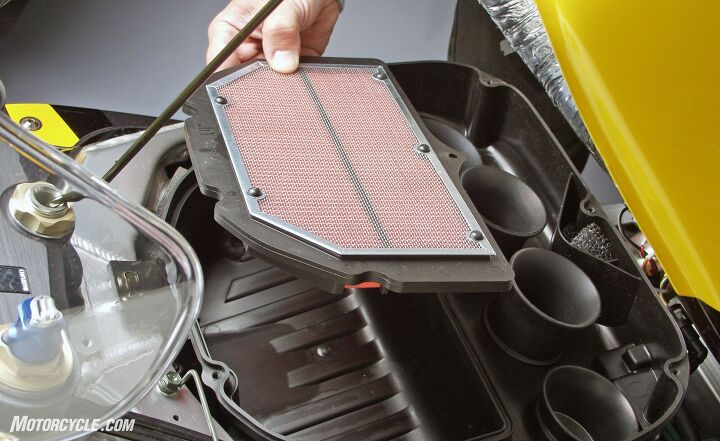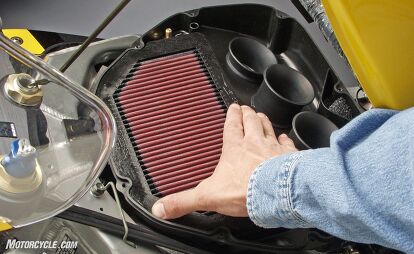MO Wrenching: Air Filter Maintenance

Help your motorcycle breathe deeply
Back in the Dark Ages, a great way to increase your bike’s horsepower was to toss the stock airbox, install a set of pod filters, and rejet your carbs. Well, all that changed with the advent of ram air, which forces cool, outside air into the airbox. The faster you go, the more air forced into the mixers, giving the bike more power. One thing hasn’t changed, though. For your engine to operate at peak efficiencies, the air filter needs to be clean to allow maximum airflow. Even though your EFI’s oxygen sensor can adjust the air/fuel mixture to compensate for a clogged filter. If you let your filter get dirty, you’ll still experience power loss and reduced gas mileage. Regular – or at least annual – cleaning of your bike’s air filter is a simple way to keep it running great.
Gaining access to your bike’s air filter isn’t too difficult on most motorcycles. Many sporty bikes, like the GSX-R750 shown here, provide a means of tilting the gas tank out of the way. Some cruisers make the job even easier by locating the filter on the side of the engine.
Before you start wrenching, consult your owner’s or factory service manual to see if the seat or any bodywork needs to be removed prior to unbolting the tank. If your bike requires that the tank be removed, be sure to place a rag below the fuel line you’ll be disconnecting. Remove the bolts securing the tank and loosen the bolt on the tank’s pivot.
Lift the tank up and insert a prop to hold it securely out of your way. Give the top of the airbox a quick blast with compressed air to clear out any dirt that may have accumulated in the screw holes. Remove the Phillips head screws on the airbox cover, making sure that you don’t drop any into the depths of the engine compartment, never to be seen again. You may find that the screws closest to the tank’s pivot can only be accessed with a stubby screwdriver or by tilting the tank so that it is vertical. (If the tank is full, some gas may leak out of the cap or into the charcoal canister – both bad things – so hold the tank vertical for as short a time as possible.)
Once all of the screws are removed, remove the lid and inspect the airbox to determine the path of airflow in from the outside. Carefully, remove the air filter, making sure you don’t knock any grit into the clean side of the airbox. If the top of the airbox is going to be off for more than a minute or so, cover the throttle intakes with clean rags or paper towels.
The kinds of air filters used vary by manufacturer. Generally, you will clean foam filters in a solvent. Paper filters can be blown out with compressed air from the back side of the filter. The best idea, though, is to buy an aftermarket filter, such as BMC, K&N, or Sprint. These pleated filters are reusable and should last the life of your motorcycle. The BMC and K&N filters are constructed out of cotton that is trapped between two sheets of wire mesh while Sprint filters swap polyester material for the cotton. The manufacturers make sure that the filters will not require rejetting. So, they are true drop-in replacements to the OE versions. While they may cost more to replace, you will save money over the years that you own your bike.
Sprint says that all you need to do to clean one of its filters is blow it out with compressed air from the clean side. Easy-peasy.
Cleaning a reusable cotton filter is a four-part operation. First, spray or pour on the solvent to cut the oil that is used to trap the dirt and let it soak for a few minutes. Rinse the oil out from the back side (the clean side) of the filter with cold water until the cotton fibers are clean. Dry the filter by placing it in the sun for a few hours or hanging it in your garage overnight. Do not use compressed air or a hair dryer unless you want to shrink the cotton and render the filter useless. When it’s dry, you want to coat the cotton with filter oil. (Never use any other kind of oil but filter oil.) If you are using a spray, one pass per pleat will suffice. For squeeze bottles, make one pass per pleat in the bottom of the pleat. Don’t saturate the filter. Let it sit for 20 minutes and re-oil any white spots on the cotton.
Installing a fresh or cleaned filter is as easy as it’s removal. However, you should make sure that you have the filter facing the correct direction. For example, paper filters will generally have a screen to support the back of the filter to keep it from flexing or tearing during operation. If your airbox has an O-ring to seal the filter access, ascertain that it is in position. After you place the lid on the airbox, take a moment to make sure that it is seated properly. Screw the lid in place in an alternating pattern (rather than going around the circumference) to make sure that the pressure is evenly applied. Reinstall the tank, bodywork, and seat as necessary—and breathe easy.
[This article was adapted from Evans Brasfield’s book 101 Sportbike Performance Projects. Learn more about it here. Read the MO review here.]

Like most of the best happenings in his life, Evans stumbled into his motojournalism career. While on his way to a planned life in academia, he applied for a job at a motorcycle magazine, thinking he’d get the opportunity to write some freelance articles. Instead, he was offered a full-time job in which he discovered he could actually get paid to ride other people’s motorcycles – and he’s never looked back. Over the 25 years he’s been in the motorcycle industry, Evans has written two books, 101 Sportbike Performance Projects and How to Modify Your Metric Cruiser, and has ridden just about every production motorcycle manufactured. Evans has a deep love of motorcycles and believes they are a force for good in the world.
More by Evans Brasfield







































Comments
Join the conversation